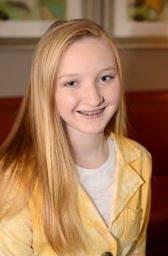Brain Tumor
Ross and Ingrid Thompson only thought they knew the meaning of the word “hope” when they named their newborn daughter Alexandra Hope. But 12 years later, the word would take on an even deeper meaning when Alex was diagnosed with a brain tumor. It began as a typical Monday at Hewitt Trussville Middle School, where Alex is a 7th grader. “I was fine and then I felt like a hammer had struck my forehead,” Alex remembers. “My head felt really heavy and I couldn’t turn my head. I made it to the bathroom, was sick and then the school nurse came to help me.” She stayed home on Tuesday and Wednesday, but returned to school on Thursday and even attended cheerleading practice that afternoon in preparation for a competition. But by the evening, she was sick again and on Friday, Ingrid took her daughter to the pediatrician. “My husband and I are both registered nurses, and we felt comfortable monitoring her,” Ingrid says. “We thought it was just a stomach virus, but when she wasn’t getting better after several days, it was time to go to the doctor.” Even after the pediatrician recommended further testing at Children’s of Alabama, the Thompsons were not overly concerned. “After ruling out bacterial meningitis, they recommended that Alex stay in the hospital for the weekend and get some fluids since she was dehydrated,” Ingrid recalls. “But Alex was still complaining of a headache, so I said, ‘Do you think maybe you should do a CT scan?’ They did, and that’s when they found the tumor near her brain stem.” A subsequent MRI showed the tumor was not cancerous but instead was a cerebral arteriovenous malformation, a condition that occurs when arteries in the brain connect directly to nearby veins without having the normal vessels (capillaries) between them. Surgery was the only treatment for Alex, but it was not without risks. “We were told she could have a stroke, memory loss, balance issues or other neurological deficits,” Ingrid says. “We were told she could bleed out and die.” The team at Children’s moved quickly to schedule Alex’s surgery with neurosurgeon James Johnston, MD. As the Thompsons watched their daughter being rolled away to the operating room, they could not have imagined that two additional surgeries would be necessary over the course of one week. “After doing an angiogram, they saw that the malformation was not on the brain stem, but deeper in a curved portion of the cerebellum,” Ingrid explains. “An angiogram after the first surgery revealed that more blood vessels were tangled underneath, so they went back in for a second time. A further check with an angiogram and CT scan showed additional vessels curled further underneath the cerebellum, so they went back again to get it all. “We had complete confidence in Dr. Johnston’s skill and his decisions,” she adds. “He was determined to get all of the malformation because if any had remained, it could have re-fed itself and Alex would have been in the same situation all over again. It could have ruptured at any time and she could have bled out.” Ingrid remembers seeing her daughter for the first time after the third surgery. “She opened her eyes and she said, ‘My name is Alex Thompson and I am in Children’s Hospital and it is 2012 and I can stick out my tongue and wiggle my toes.’ By this time, she had had several neuro checks and she knew the drill so she just did it before even being asked. That was probably one of the happiest moments of my life.” Ross says his family was blessed not only by the world-class medical care, but also by the chaplaincy program at Children’s. “Chaplain Paul Byrd was really a pillar of strength for us at that time. He came in to see us with some prayer stones he carries with him – stones with words on them like ‘faith’ or ‘strength’ or ‘prayer.’ We each took a stone and were touched to see our stones both had the word ‘hope’ – Alex’s middle name. “Paul told us he could not remember ever having two stones with the same word – and he didn’t know the word’s significance to us at the time,” he adds. “God has blessed us so much through this whole experience. Hope was the word we were given, and we carried that word and those stones with us throughout Alex’s hospitalization. Even now that she is recovering and back at school, we carry that word and draw strength from it.”











